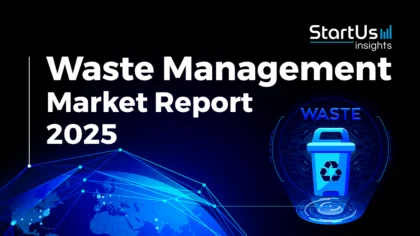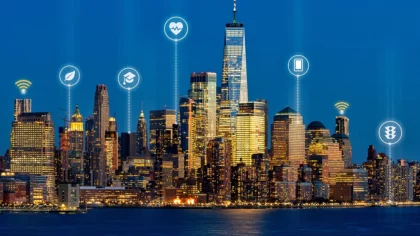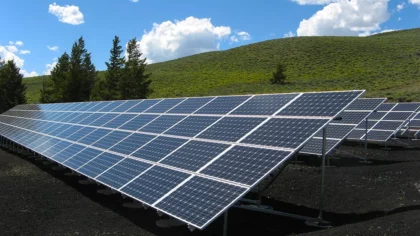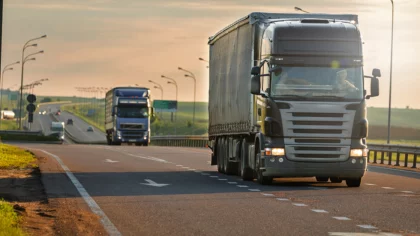Accelerate Productivity in 2025
Reignite Growth Despite the Global Slowdown
Executive Summary: What are the Top 10 Smart City Trends in 2025 & Beyond?
The global smart city market is expected to grow from USD 699.7 billion in 2025 to USD 1445.6 billion by 2030 with a strong compound annual growth rate (CAGR) of 15.6%. The top smart city trends shaping the sector are:
- Urban Transportation: AI-driven traffic systems like Pittsburgh’s Scalable Urban Traffic Control (SURTRAC) cut travel time by 25% and emissions by 20%. Mobility-as-a-service (MaaS) platforms like Helsinki’s Whim shifted 38% of users off daily car use. Robotaxis, AI metros, and smart parking systems are scaling globally as EV infrastructure expands.
- Smart Waste Management: Internet of things (IoT)-enabled bins aided cities like Barcelona to cut overflow incidents by 80%. Pneumatic waste systems in Bergen slashed truck runs by 90%. Compacting bins from Ecube Labs reduced collection frequency by up to 80% in Seoul and Melbourne.
- Energy-Optimization: California’s Tesla-run virtual power plants provide 100 MW of clean backup power. Peer-to-peer solar trading in India cut energy rates by 43%. Microgrids like Calistoga’s deliver carbon-free electricity for 48 hours during outages.
- Public Safety and Security: AI-powered video analytics reduce crime by up to 40% and emergency response times by 35%. Dallas’s sensor-laden smart neighborhoods saw sharp crime drops. Real-time crime centers (RTCCs) and robotic patrols are scaling for real-time intervention.
- Smart Buildings: Buildings use 30% of global energy, and smart tech slashes this by up to 40%. Cisco and Sentiom‘s fire and leak sensors automate maintenance. Singapore’s Green Plan targets 80% green-certified buildings by 2030.
- Climate Mitigation: Biosolar rooftops cut cooling needs by 25% and reduce roof surface temperatures by up to 40°C. Songdo’s USD 40 billion smart infrastructure reduces waste truck emissions via underground pneumatic collection.
- Disaster Management: Google’s Flood Hub alerts reach 700 million users across 100 countries. Jakarta’s machine learning (ML)-based flood warning systems now monitor rainfall, drainage, and river flow in real time. Vertical take off and landing (VTOL) aircraft from HazelAero offer amphibious disaster relief.
- 5G and 6G Connectivity: Cellular IoT links in cities are growing at 17.9% annually. Bellantenna‘s adaptive antennas reduce urban signal interference, while Airbeam‘s mesh systems enable high-speed smart grid control.
- E-Governance: Over 50 nations now offer fully online tax and business services. India’s Smart Cities Mission completed 90% of projects across 100 cities. AI chatbots, blockchain property titles, and multilingual platforms are streamlining public workflows.
- Urban Farming: Urban farms using aeroponics and AI reduce land use by 99%. Tomato Town‘s closed-loop systems grow food with minimal energy. Farmvent enables restaurants to grow multiple crops on-site year-round.
Read on to explore each trend in depth – uncover key drivers, current market stats, cutting-edge innovations, and smart city leading innovators shaping the future.
Frequently Asked Questions
1. What is a smart city?
A smart city uses digital technology like internet of things (IoT), artificial intelligence (AI), and real-time data to improve services, sustainability, and citizen quality of life.
2. What are the future smart city trends?
Key trends in 2025 include AI-powered transit, IoT-based waste systems, smart buildings, 5G/6G networks, and urban farming.
3. What are the emerging smart city technologies?
Smart cities are adopting edge computing, autonomous mobility, AI surveillance, vertical farming, and microgrids.
Methodology: How We Created the Smart City Trend Report
For our trend reports, we leverage our proprietary StartUs Insights Discovery Platform, covering 7M+ global startups, 20K technologies & trends plus 150M+ patents, news articles, and market reports.
Creating a report involves approximately 40 hours of analysis. We evaluate our own startup data and complement these insights with external research, including industry reports, news articles, and market analyses. This process enables us to identify the most impactful and innovative trends in the smart city industry.
For each trend, we select two exemplary startups that meet the following criteria:
- Relevance: Their product, technology, or solution aligns with the trend.
- Founding Year: Established between 2020 and 2025.
- Company Size: A maximum of 200 employees.
- Location: Specific geographic considerations.
This approach ensures our reports provide reliable, actionable insights into the smart city innovation ecosystem while highlighting startups driving technological advancements in the industry.
Innovation Map outlines the Top 10 Smart City Trends & 20 Promising Startups
For this in-depth research on the Top Smart City Trends & Startups, we analyzed a sample of 1970+ global startups & scaleups. The Smart City Innovation Map created from this data-driven research helps you improve strategic decision-making by giving you a comprehensive overview of the smart city industry trends & startups that impact your company.
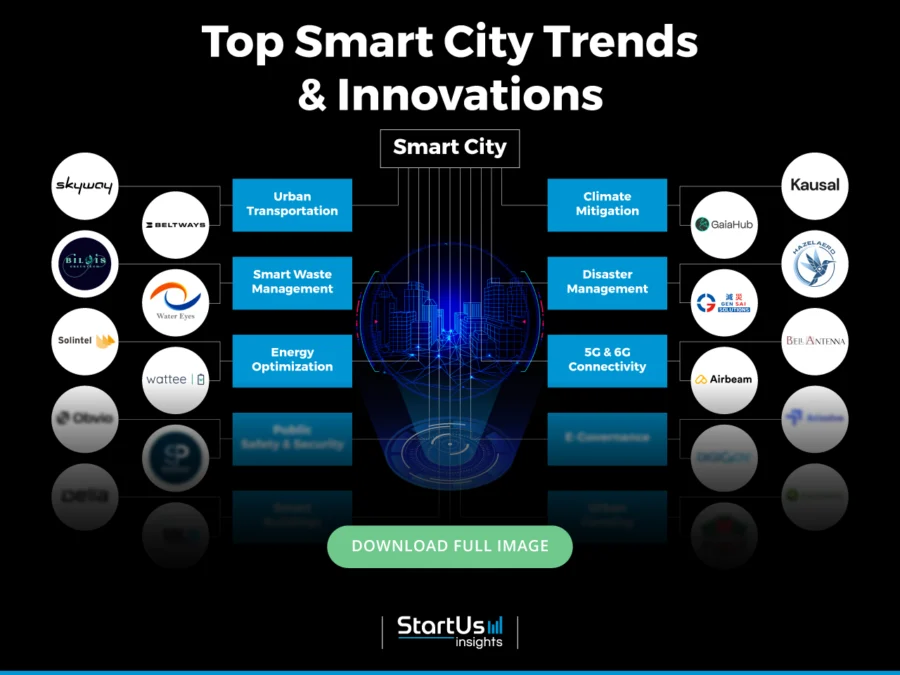
Tree Map reveals the Impact of the Top 10 Smart City Trends
Smart cities are evolving through the integration of intelligent infrastructure and public service innovation. Urban transport systems use real-time routing and electrification to enhance mobility and also support multimodal integration for commutes.
Waste management now applies sensor-based monitoring to raise collection efficiency and improve environmental performance. Similarly, smart buildings support energy savings and promote occupant wellness.
Meanwhile, public safety and disaster response tools rely on AI and data analytics for quicker action. In addition, 5G and 6G networks enable stronger urban connectivity. Urban farming projects also strengthen local food systems.
These developments show how cities are becoming tech-enabled, sustainable, and responsive spaces.
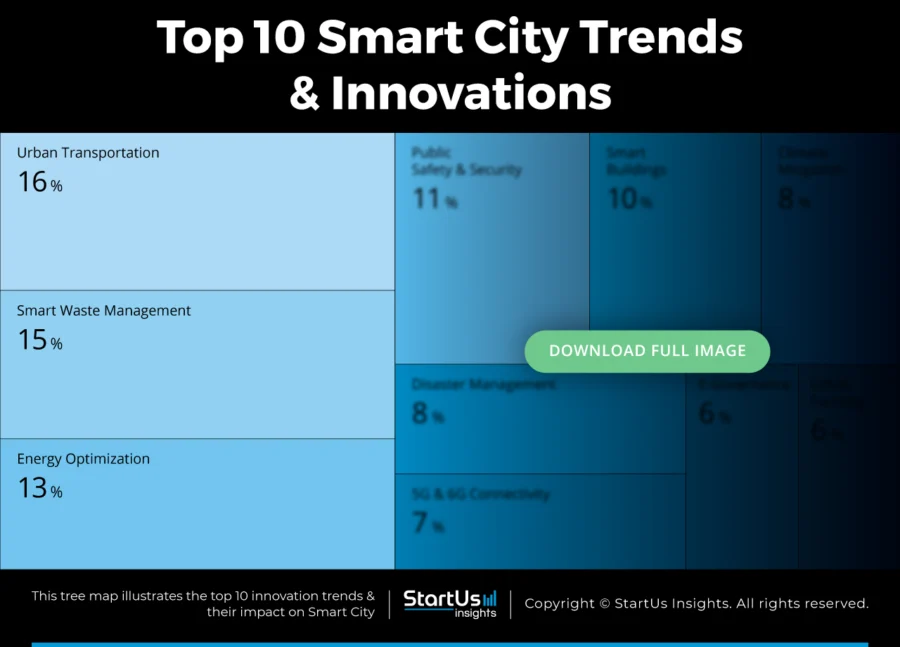
Global Startup Heat Map covers 1970+ Smart City Startups & Scaleups
The Global Startup Heat Map showcases the distribution of 1970+ exemplary startups and scaleups analyzed using the StartUs Insights Discovery Platform. It highlights high startup activity in the USA and India, followed by Germany. From these, 20 promising startups are featured below, selected based on factors like founding year, location, and funding.
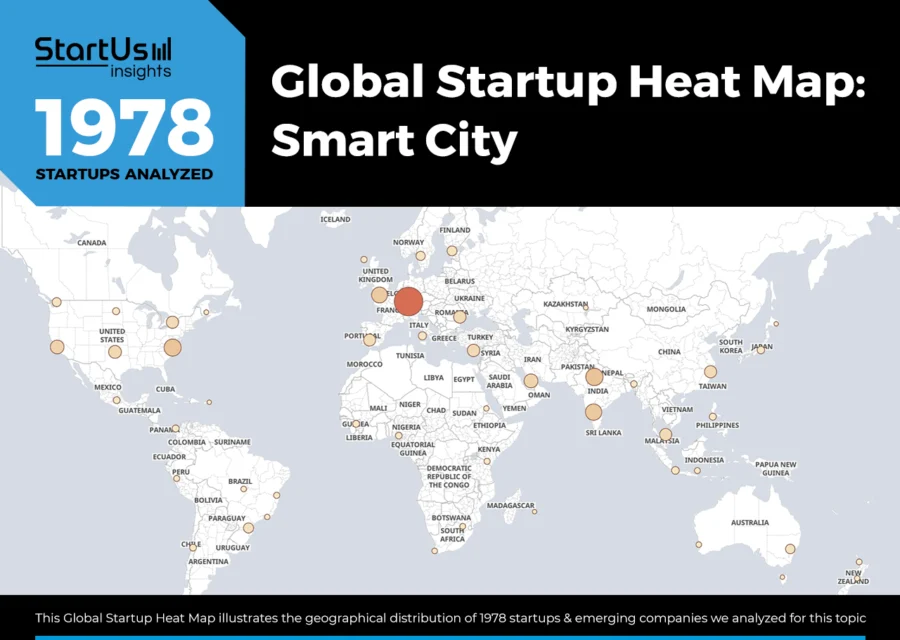
Want to Explore Smart City Innovations & Trends?
Top 10 Emerging Smart City Trends [2025 and Beyond]
1. Urban Transportation: Market to Reach USD 250 B by 2030
Traffic congestion, air pollution, and limited transit access are driving cities to rethink their transportation infrastructure. A more integrated, tech-enabled mobility ecosystem is emerging, focused on efficiency, accessibility, and sustainability.
The global urban mobility market expanded from USD 153.92 billion in 2024 to USD 167.04 billion in 2025. With a projected CAGR of 8.45%, it is expected to reach USD 250.56 billion by 2030.
This growth reflects rising investments in intelligent transportation solutions that improve urban efficiency. A case in point is Pittsburgh’s AI-powered SURTRAC. It reduced travel times by over 25%, cut wait times by up to 40%, and lowered emissions by 20% in its pilot phase.
MaaS platforms unify public transit, ride-share, and micromobility into single apps. Helsinki’s Whim service led 38% of users to replace daily car trips, with 95% of trips involving public transportation. This underscores its role in reducing private car dependency.
Autonomous and electric vehicles are also gaining traction. Waymo‘s robotaxis, already operational in Phoenix and San Francisco, applied to resume supervised testing in New York City in July 2025. The company also advocates for legislative changes to enable fully driverless operations.
Meanwhile, India’s Indore Metro, equipped with AI-driven train monitoring, QR-code ticketing, and platform screen doors, demonstrates the emergence of smart infrastructure in growing urban centers.
Microtransit services solve last-mile connectivity issues in suburban and low-density areas. App-based on-demand minibuses, piloted in The Woodlands, Texas, and mid-sized Canadian cities like Innisfil and Cochrane, improve accessibility without relying on fixed routes or timetables.
On the other hand, electric vehicle (EV) infrastructure and smart parking have become pillars of sustainable urban mobility. With EV adoption projected to exceed 250 million vehicles globally by 2030, cities roll out real-time parking platforms with integrated charging.
For instance, Amsterdam’s Dynamic Guided Parking System (DGPS) uses wireless sensors to reduce CO2 emissions and “search traffic.” Moreover, companies like Flowbird and Parkopedia work with city governments to deploy AI-enabled parking solutions with demand forecasting and dynamic pricing.
Skyway advances Air Traffic and Vertiport Management
US-based startup Skyway builds autonomous systems that manage air traffic and vertiport operations for air mobility. It uses ML and low-altitude weather tracking to guide eVTOL and drone traffic across urban and regional skies.
The startup pulls real-time data from sensors, flight centers, and regulatory sources to support navigation and emergency response. It also offers digital vertiport tools for parking, charging, and maintenance of eVTOLs.
Additionally, it supports beyond visual line of sight (BVLOS) drone flights with AI-based mission planning. It offers features such as risk assessments, scheduling modules, and gate management for automated aviation.
Beltways creates a High-capacity Smart Walkway
US-based startup Beltways develops a patented modular walkway system for last-mile pedestrian transit. It uses above-ground modules that assemble with minimal construction, which allows for quick deployment across diverse locations.
The startup’s system gradually adjusts speed, reaching up to 10 mph depending on its length. It activates segments only when it detects passengers through smart motion sensors.
It also includes an IoT-driven safety setup with automatic shutdown protocols. Further, manual overrides support user safety across age groups.
The enterprise SaaS platform provides analytics on foot traffic, energy use, and maintenance trends. In addition, integrated LED sidewalls enable real-time displays and dynamic signage.
2. Smart Waste Management: Led to 80% Overflow Incident Reduction
Rising waste volumes, overflowing bins, and mounting environmental concerns push cities to adopt smarter waste systems. The global smart waste management market is growing. It grew from USD 2.73 billion in 2024 to an estimated USD 3.17 billion in 2025. With a projected CAGR of 16%, it is further expected to reach USD 14 billion by 2035.
The IoT-based fill-level sensors are embedded in bins. They send real-time alerts when nearly full, enabling dynamic, demand-based collection. This saves fuel, cuts CO2 emissions, and improves operational efficiency.
Moreover, in certain cities, the use of IoT-enabled waste bins led to an 80% reduction in overflow incidents. Barcelona implemented such IoT-enabled bins citywide. Integrated with centralized analytics, the system optimizes routes and reduces unnecessary pickups.
Norwegian city Bergen takes it a level further. It installed an advanced pneumatic waste collection network beneath its medieval city center. Household trash is vacuumed through underground tubes to centralized facilities. This reduces garbage truck runs by up to 90%, cuts diesel emissions, and eliminates rats and fire hazards. On top of that, it increases recycling by 15% via “pay-as-you-throw” fees.
Complementing such infrastructure advances, leading innovator Ecube Labs is transforming street-level collection. It develops a solar-powered, compacting bin, CleanCUBE. It holds up to 5 times more waste compared to non-compacting bins and reduces collection frequency by 80%. For example, Melbourne saw 96% fewer collections, and Seoul experienced 83% cost reductions by deploying Ecube Labs’ bins in high-traffic zones.
Alongside, smart sorting systems improve recycling rates at materials recovery facilities. For instance, Waste Robotics uses AI-ready robotic arms with hyperspectral imaging to identify and sort plastics, metals, and construction and demolition (C&D) waste with high accuracy.
These innovations are not isolated; they are part of a growing policy-supported movement. 65% of municipalities now integrate smart waste solutions into their climate action strategies, with pilot programs delivering 20-50% in operational savings. Thus, they reinforce the economic and environmental value of intelligent waste management.
Bilqis GreenTech manufactures Autonomous Waste Management Robots
UAE-based startup Bilqis GreenTech creates solutions that integrate autonomous waste collection with real-time environmental, social, and governance (ESG) analytics. It deploys a robot that moves through streets and public spaces to detect and sort waste at the source.
Further, the onboard sensors and algorithms support this process. The robot enables the reduction of manual labor and improves hygiene. It also diverts recyclable materials from landfills.
Meanwhile, the system sends data to Bilqis Analytics, a cloud platform that tracks waste flows and spots inefficiencies and also generates ESG compliance reports. The platform facilitates material exchange by linking reusable waste with local demand and supports zero-waste goals.
Water Eyes enables Wastewater Quality Management
South Korean startup Water Eyes builds intelligent systems for monitoring water quality in marine, freshwater, and wastewater settings. It uses underwater sensors, surface cameras, and compound modules to track multiple parameters, even in high-concentration wastewater.
The system sends real-time data to a dedicated application. There, AI tools analyze trends, flag anomalies, and suggest operational adjustments to enable a timely response to pollution.
Besides, the hardware is durable and requires low upkeep. Its design supports correlation-based analysis and works with hydrodynamic models to improve diagnostics. Also, installers are able to deploy the startup’s system at wastewater plants or coastal zones.
3. Energy Optimization: Carbon-free Power Backup up to 48 hours
Rapid urbanization strains energy systems by powering more demand, fragile grids, and the urgency for climate resilience. Energy efficiency and optimization emerge as a top priority.
One of the major innovations in this segment comprises the rise of microgrids that operate independently or with the main grid. A leading example of modern urban microgrids is the Calistoga Resiliency Center in California.
Developed by Energy Vault, this hybrid hydrogen fuel-cell and lithium-ion battery system provides a carbon-free backup to the city for up to 48 hours. It delivers 8.5 MW peak power and 293 MWh of storage during wildfire-related power shutoffs. It replaces noisy diesel generators and emits only water vapor to offer a clean, community-scale resilience model.
Peer-to-peer energy trading is another growing trend. In Uttar Pradesh, India, a pilot project was led by Powerledger, Uttar Pradesh Power Corporation Limited (UPPCL), and Uttar Pradesh New and Renewable Energy Development Agency (UPNEDA). It enabled blockchain-based peer-to-peer rooftop solar trading.
Using Powerledger’s xGrid platform, prosumers sold excess energy directly to local consumers at rates 43% lower than retail tariffs. The system offered transparent, real-time transactions and allowed discoms to meet renewable energy targets without new infrastructure.
Building on similar principles of decentralized energy use, vehicle-to-grid (V2G) systems enable EVs to discharge stored energy back to the grid during peak demand. China plans to initiate pilot projects in nine cities, such as Beijing, Shanghai, Shenzhen, and Guangzhou. These projects will deploy vehicle-to-grid (V2G) technology to allow EVs to store and discharge electricity back to the grid for stabilizing supply during peak demand.
Continuing this trajectory, virtual power plants (VPPs) aggregate distributed energy resources, such as solar panels, batteries, and EV chargers, into a unified, grid-responsive entity. In California, Tesla-run VPPs now contribute up to 100 MW of peak capacity. This capacity matches that of a small gas plant. By dispatching clean and stored energy, it stabilizes the grid during heat waves and emergencies while also reducing reliance on costly, polluting peaker plants.
Solintel develops Wind-powered LED Streetlights
Estonian startup Solintel builds integrated solutions that combine smart energy management with autonomous, renewable-powered systems. It operates Solintel Intellifos, a modular platform for lighting and utilities that runs on solar, wind, and battery storage.
It uses an AI-based controller and software to coordinate its functions. The startup’s platform supports street lighting, environmental monitoring, micro-mobility charging, and energy sharing. It works on-grid, off-grid, or within a microgrid.
The platform includes remote controls, automated settings, and a plug-and-play setup that simplifies deployment. Solintel fits both urban and rural areas.
Wattee makes AI-driven Photovoltaic Power Plants
Czech Republic-based startup Wattee creates AI-enabled photovoltaic power systems for homes, businesses, and municipalities. Its system combines solar panels, smart inverters, and battery storage with a control platform that learns energy usage patterns.
Further, it manages energy generation, storage, and grid interaction automatically. Users are able to track real-time data through a mobile app. This allows them to plan energy use and trade electricity efficiently on the spot market.
Wattee supports modular setups and works with EV charging stations. It allows installers to tailor it to homes, offices, or apartment buildings.
4. Public Safety and Security: AI Reducing Crime Rates by 40%
In a 2023 global survey, half of government respondents named public safety as the main driver of their smart city efforts.
Governments increase investments in safe city initiatives. In addition, growing urban security concerns and access to AI-powered surveillance technologies drive this trend.
AI advancements reshape law enforcement and public safety operations. Studies show that using tools like video analytics, facial recognition, and predictive algorithms lowers crime rates by up to 40%. They also reduce emergency response times by as much as 35%.
Most police agencies, around 90% now, support the use of AI. It aids in reducing crime through analytics and improved decision-making. For instance, real-time video analysis identifies suspects quickly, which speeds up response and saves lives.
Meanwhile, IoT devices serve as the foundation of smart city safety. Connected cameras, smart streetlights, and sensors gather data continuously. This stream of information enables officials to respond more effectively.
Cities deploy technologies like gunshot detection systems, AI-enhanced closed-circuit television (CCTV), and sensor-equipped lighting that adjusts to unusual movement or alerts police when needed.
For instance, a pilot in Dallas’s Red Cloud neighborhood includes AI-enabled cameras, upgraded LED streetlights, public Wi-Fi, and 52 environmental sensors. Since the installation, crime rates have dropped. The system captures illicit activity, and residents report greater peace of mind.
Another growing trend is the rise of real-time crime centers (RTCCs). These command hubs consolidate live feeds from cameras, 911 calls, and sensors to support fast, informed action.
Las Vegas, for instance, launched smart parks equipped with IoT sensors and video analytics. These parks detect after-hours activity or unusual gatherings and trigger alerts to city safety teams.
Additionally, cities pilot drones and robotic patrols. Drones with thermal cameras assist with early wildfire detection and search-and-rescue. Besides, ground-based robots monitor parks and transit stations, extending the capacity of human officers.
Obvio enables AI-powered Traffic Accident Prevention
US-based startup Obvio builds AI-based systems to monitor traffic and reduce reckless driving. It installs solar-powered pylons with edge AI that analyzes video on-site.
The startup’s system identifies behaviors like speeding, red-light violations, and distracted driving. It runs independently without utility connections.
Further, the detected events are uploaded instantly through 5G. It includes driver alerts, LED signs, and dashboards that support community engagement. These tools turn data into actionable responses.
Obvio allows municipalities to manage traffic risks and improve street safety with automated detection and behavioral analysis.
SmartProtect advances Public Safety Staff Management
US-based startup SmartProtect develops perimeter security and public safety platforms that use AI and predictive analytics. Its system combines radar, thermal imaging, and motion detection to identify threats in real time. It sends alerts and supports live monitoring for rapid response.
The startup’s SmartProtect Nexus automates scheduling and centralizes incident data through a secure cloud platform. It also provides insights that allow agencies to plan shifts and coordinate across departments. Further, personnel wellness tracking is built into the system.
Additionally, its SmartProtect Predict analyzes calls, response times, and staffing patterns to guide resource allocation.
5. Smart Buildings: 80% of All Buildings to be Green-Certified by 2030
Efficiency remains a top priority due to rising utility costs and sustainability objectives. According to the International Energy Agency, buildings consume 30% of the world’s energy; therefore, reducing this consumption with smart technology is beneficial.
To ensure sustainable urban expansion, governments around the world sponsor smart innovations, such as connected buildings and smart grids. They communicate with municipal infrastructure, such as the electrical grids, and optimize energy and water use. For instance, as part of its Smart Nation project, the Singapore Green Plan 2030 program seeks to have 80% of all buildings green-certified by 2030.
Further, real-time monitoring from occupancy to energy use is now possible due to IoT sensors and cloud connectivity. Analytics and AI process this data to continuously improve operations. In trial projects, advanced IoT-based building controls have been demonstrated to reduce energy consumption by 40% and maintenance expenses by 10% to 30%.
Cisco Canada and Sentiom, a proptech firm, collaborated to introduce a smart building system in June 2023. It employs cloud analytics and IoT sensors to identify fire hazards and water leaks in multi-residential complexes.
Smart buildings also address the increased emphasis on safety and healthy interior conditions brought on by the COVID-19 pandemic. Smart heating, ventilation, and air-conditioning (HVAC) filtration, occupancy monitoring, touchless entry, and cleaning automation now prioritize occupant well-being as offices and public buildings reopen.
Building owners use IoT sensors to monitor air quality (CO₂ levels, ventilation rates). They use analytics to make real-time adjustments to airflow and spacing. This restores occupant confidence and makes spaces safer and more comfortable. Besides, to create a safe space after the epidemic, business landlords implement temperature screening, smart entry systems, and flexible cleaning schedules.
For optimum effect, many projects combine sustainable design and materials with intelligent controls. For example, Helsinki’s Wood City project develops high-rise structures with smart systems and fire-resilient engineered wood, an environmentally benign material.
At a CAGR of 10.70% from 2025 to 2034, the smart building market is expected to grow from USD 111.51 billion in 2025 to over USD 277.92 billion by 2034.
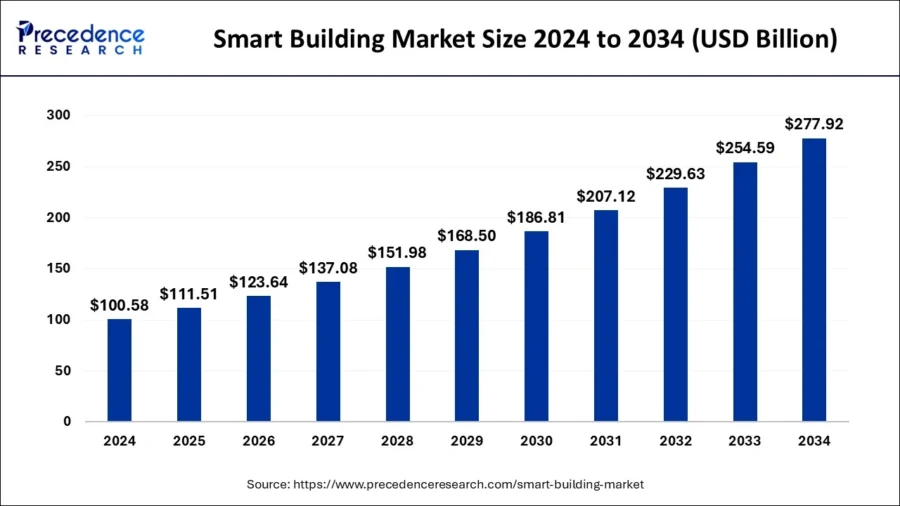
Credit: Precedence Research
Della builds a Smart Building Operating System
Canadian startup Della makes an AI-powered operating system for smart buildings. The platform unifies property management and resident services through a single digital interface. It merges access control, smart locks, HVAC, thermostats and leak detection into one dashboard for operators.
Residents use a mobile app to interact with the same system. Integrators deploy custom solutions quickly using installer tools and Mission Control. Property managers use the platform to manage announcements, bookings, and maintenance tasks.
Further, Della OS also connects with third-party systems and adjusts resident interfaces to match building branding.
Sol-In enables Indoor Air Quality Monitoring
Israeli startup Sol-In creates AI-based solutions for indoor air quality (IAQ) management in smart buildings. Its platform links smart sensors throughout a facility to track CO₂, particulate matter 2.5 (PM2.5), volatile organic compounds (VOCs), temperature, and occupancy.
It sends data to a central dashboard for real-time analysis and decisions. The startup’s platform works with existing building management systems or runs on its own.
Besides, it adjusts ventilation automatically based on air quality and space usage. The key tools include predictive maintenance, ESG reporting, and support for WELL, leadership in energy and environmental design (LEED), and regenerative ecological social & economic targets (RESET) certifications.
Sol-In makes air quality visible and optimizes HVAC use, which cuts energy use, reduces emissions, and improves occupant well-being.

6. Climate Mitigation: Global Climate Tech Market to Reach USD 115 M by 2030
Following the Paris Agreement, nations and cities increased their climate commitments. By mid-2024, 148 countries representing 88% of the global population set net-zero emissions targets.
Public expectations for sustainable urban living are rising. Climate disasters and pollution underscore the risks of inaction. City leaders see themselves as key actors in delivering practical solutions.
Cities adopt renewable energy and smarter grids. Masdar City in the UAE, for example, runs on clean energy from solar farms and wind turbines. Its buildings consume less energy than standard structures.
Urban transport electrification plays a central role in climate action. In 2024, electric vehicle sales reached 17 million, accounting for over 20% of new cars sold. Projections for 2025 exceed 20 million, with EVs expected to make up more than one-quarter of global sales. To support this shift, cities expand charging networks and convert public fleets.
Buildings are major contributors to emissions that prompt a move toward efficient urban design. Climate technologies in construction now target both embodied and operational carbon. New materials and biosolar green roofs reduce air-conditioning demand. These roofs lower cooling energy use by up to 25% and cool roof surfaces by 30-40 °C.
In South Korea, Songdo was built on reclaimed land with integrated smart systems. By 2025, investments in its infrastructure surpassed USD 40 billion. Buildings in Songdo include sensors linked to a central system, where waste moves through underground networks instead of trucks. Besides, traffic and lighting systems adjust in real time to reduce energy use.
Looking ahead, the global climate tech market is projected to reach USD 115.4 million by 2030, with a CAGR of 20.9% between 2025 and 2030.
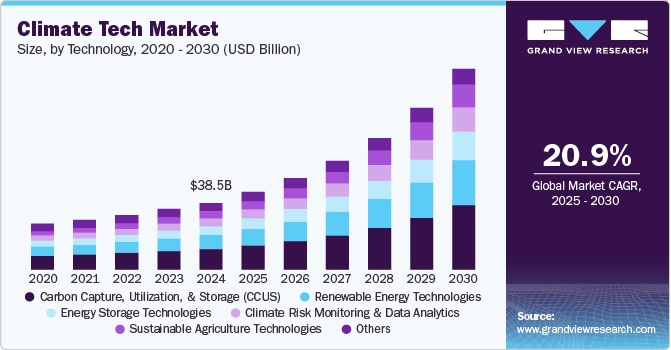
Credit: Grand View Research
Kausal enables City Climate Goal Planning and Tracking
Finnish startup Kausal provides a digital platform that enables cities to plan and manage climate action. It lets municipalities set emission goals, design action plans, and track progress using real-time data.
The startup’s platform includes Kausal Watch, which brings all climate activities into a single interface. It shows implementation status, allows flexible categorization, and supports transparent reporting. It allows stakeholders to engage through shared workflows.
In addition, Kausal Paths provides scenario modeling to explore the effects of different strategies. Users compare outcomes based on policy choices, population trends, or technology use.
GaiaHub supports Urban Mobility Climate Monitoring
Estonian startup GaiaHub develops a geospatial intelligence platform to support land management and monitor urban emissions. It uses satellite data, AI tools, and real-time tracking to measure vegetation health, soil moisture, and carbon storage.
The platform also collects near-real-time air quality data, including CO₂, NOx, and PM2.5 levels in cities. In addition, it links license plate recognition with traffic and emissions data to map mobility trends and forecast pollution. These insights guide city planning and policy.
Further, users are able to access dashboards to study trends, test scenarios, and generate custom reports that align with EU sustainability targets. GaiaHub blends ecological tracking with urban data that enables cities, transport operators, and landowners to make informed decisions that improve climate resilience and public health.
7. Disaster Management: Reducing Climate Hazards a Top Priority for 70% of Municipalities
Cities are particularly vulnerable to the effects of climate change, including heat waves and more powerful storms. The warmest year on record was 2023, and urban stressors like water scarcity are getting worse due to climatic extremes.
69% of city resilience officers worldwide who participated in the Resilient Cities Network’s Chief Resilience Officer poll cited climate change as the top stressor confronting their community. In recent years, reducing climate-related hazards has been a top resilience objective, according to over 70% of municipalities worldwide.
Investors, insurers, and governments take notice of the growing cost of disasters. More national and local governments provide funds for smart resilience initiatives and revise laws such as land use plans and building rules to encourage preventative actions.
Cities track environmental conditions in real time and warn populations of potential dangers with current sensing and connection. For instance, Jakarta implemented a citywide flood early warning system that analyzes rainfall, river levels, and drainage flow using ML and IoT sensors.
City officials transition from reactive to proactive catastrophe management with the use of AI and big data analytics. AI models analyze large datasets including weather forecasts, historical events, satellite photos, and more to identify high-risk locations or predict disasters days in advance.
For instance, Google’s AI-based flood forecasting project Flood Hub platform, extends to 700 million users in 100 countries.
Moreover, technology businesses and local authorities collaborate to address catastrophic concerns. One example is the IBM–C40 urban heat effort, which brought together a large tech company and a worldwide municipal network to jointly develop AI solutions.
The market for natural disaster management is projected to grow at a CAGR of 12.1% from 2025 to 2034, reaching USD 199.91 billion.
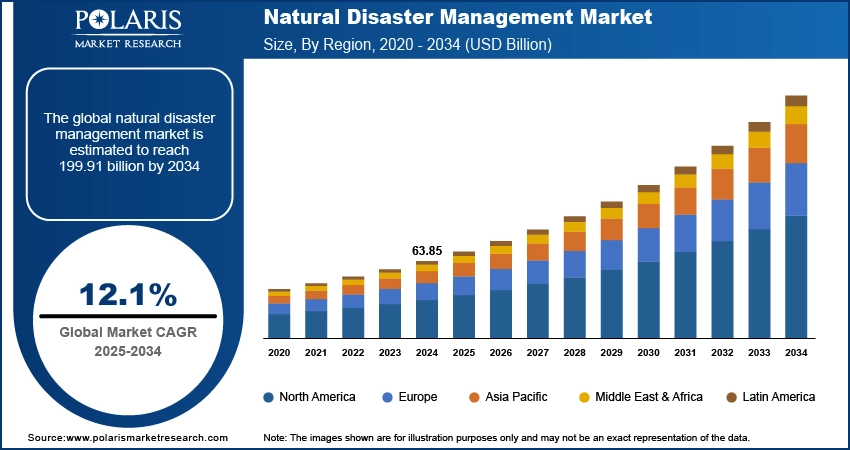
Credit: Polaris Market Research
HazelAero manufactures Natural Disaster Relief VTOL Aircraft
South Korean startup HazelAero creates electric aircraft with amphibious capabilities for disaster response and sustainable aviation. The aircraft uses zero-emission propulsion, lightweight electric systems, and VTOL functionality.
Besides, it operates in all weather and supports quick deployment during emergencies. Each unit acts as a mobile hub, carrying supplies for first responders and staying ready around the clock.
The startup’s aircraft design includes precision aerodynamics and noise reduction to lower operating costs. Further, it works across air, land, and water.
As part of emergency infrastructure, the platform supports agencies and rescue teams to deploy flexible, climate-friendly air operations.
Disaster Reduction Solutions makes the Disaster Database and the Rescue Training Module
Japanese startup Disaster Reduction Solutions offers GENSAI, an AI-driven platform that supports industrial operations and emergency response. The system connects to existing infrastructure and gathers data from sources such as sensors, maps, documents, and audio feeds. It uses AI to convert this data into a unified, structured format.
Emergency agencies use the platform to coordinate across departments. It structures inputs from police, fire units, and citizens into a shared timeline.
The startup offers key tools such as keyword recognition, geolocation mapping, and layered visuals that display needs, hazards, and available resources.
8. 5G and 6G Connectivity: 6G to Deliver User Rates of 1-10 Gb/s
Public authorities treat connectivity as essential infrastructure, and many governments allocated funds to support smart city upgrades.
5G-powered technologies manage growing data demands. For example, smart grids optimize energy use, and IoT-based waste systems streamline services. With real-time data, cities improve energy efficiency by 30% over two decades.
Falling sensor costs and AI advancements are further driving adoption. As more devices go online, cities depend increasingly on 5G. Private 5G networks expand in airports and campuses, with usage projected to rise at 65.4% annually through 2030.
Moreover, cellular IoT connections in cities grow at 17.9% each year. By 2027, they are projected to exceed 122 million active links in traffic lights, power systems, and waste bins.
Street lighting offers another use case. By 2027, over 161 million lights are expected to connect via 5G or low-power wide-area network (LPWAN). Central control systems manage brightness, detect outages, and save energy.
To process this data flood, cities will turn to edge computing. By placing small data centers at towers or cabinets, they reduce backhaul traffic and enable faster responses, useful for hazard detection or drone operations.
Some cities build dense sensor networks. New York City, for example, uses connected cameras and IoT devices to support adaptive signals and a pilot for connected vehicles.
Looking ahead, 6G aims to deliver user rates of 1-10 Gb/s, with latency below one millisecond. Trials explore 6G networks that connect ground and satellite nodes to support services like autonomous transport, remote care, and public utilities.
Edge computing and non-terrestrial networks will support in meeting future mobile traffic needs, expected to reach 5016 exabytes per month by 2030.
The global 5G infrastructure market is projected to grow at 22.9% annually from 2024 to 2030.
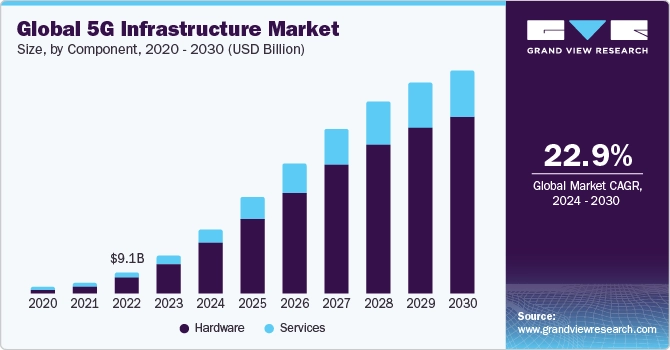
Credit: Grand View Research
Bellantenna develops Next-gen 5G Network for City Centers
Italian startup Bellantenna offers adaptive antenna systems to improve 5G performance in urban areas. Its technology uses beam steering, signal processing, and programmable hardware to adjust coverage based on user density and interference.
The system supports multi-band use and integrates with open radio access network (open-RAN) and legacy telecom infrastructure. This enables the reduction of energy use and lowers operational costs.
The antennas come in compact enclosures designed to match city architecture. They balance visual appeal with technical function.
By uniting technical efficiency and architectural fit, Bellantenna offers flexible 5G infrastructure for cities, carriers, and tech partners.
Airbeam builds Smart Cells for 5G Network
Canadian startup Airbeam develops AI-enabled wireless systems and air quality tools for 5G and smart city infrastructure. It pairs compact pollution sensors with edge computing and 60 GHz mesh networks to collect and transmit real-time data.
The system tracks pollutants like PM2.5, nitrogen oxide (NO₂), and ozone (O₃) across dense city areas. At the same time, the startup’s GigaRay Liberty backhaul delivers fiber-like speeds and stable connections for small cell deployment. These capabilities support traffic control, smart lighting, and urban IoT networks.
The platform also offers low-latency processing, scalable design, and signal stability through open protocols. Airbeam gives cities and operators the tools to improve infrastructure and public health.
9. E-Governance: 50+ Nations Already Offering Online Government Services
Cities need more intelligent administration and infrastructure during expansion. By 2050, 68% of the world’s population, more than 6 billion people, will reside in cities, according to UN projections. Governments are compelled by this urban expansion to use digital tools in order to effectively manage resources and provide services on a large scale.
Governments started initiatives to digitize services and create smart cities all over the world. For instance, India’s Smart Cities Mission completed more than 90% of the planned projects in 100 cities at an investment of about INR 1.64 lakh crore.
Today’s citizens demand the same level of convenience from their government as they do from online shopping or digital banking. This stands as one of the main forces behind the e-governance requirement.
In response, governments are introducing open data platforms, smartphone apps, and one-stop internet portals. For instance, in the last year, more than 50 nations provide online services for business registration and tax payment, and some, like Estonia, even offer e-voting.
E-governance also includes making city data publicly accessible since it encourages creativity and accountability. These days, a lot of smart cities post open datasets on public portals covering everything from budgeting to transit. Seoul and Dubai, for instance, led the way in citizen participation and open data.
Further, numerous cities updated their websites and avenues of interaction to enhance the customer experience. For example, in 2024, Scottsdale, Arizona, unveiled a new city website featuring an intent-based user interface, improved search, and a mobile-responsive design.
AI and other technologies are tested to improve city operations. Blockchain ledgers increase the effectiveness of public data and transactions. The blockchain pilot for property titles in Baltimore listed the city’s unoccupied properties on a safe blockchain network.
With a CAGR of 11.7% from 2024 to 2032, the e-government market is expected to reach USD 50.4 billion by 2032.
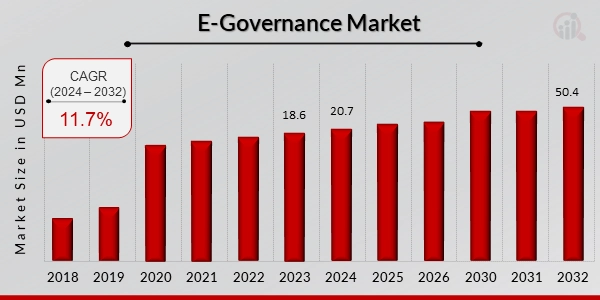
Credit: Market Research Future
Arixolve creates AI-Powered E-Governance Solutions
Indian startup Arixolve provides AI-based tools to improve infrastructure inspection, asset tracking, and e-governance. It uses computer vision and ML to automate visual checks of critical infrastructure. Besides, drones and robotics detect faults and assess asset health in real time.
In addition, the startup offers governance tools like voice-enabled chatbots and analytics dashboards to support public services. Its platform handles natural speech across Indian languages and automates document workflows.
It also delivers real-time policy insights through customizable dashboards. The core features include predictive analytics, secure data practices, and department-wide integration. Arixolve enables agencies and businesses to make informed decisions and improve service delivery by linking automation with citizen services.
DigiGov enables the Public Finance Department Digitization
Brazilian startup DigiGov develops a digital platform to support municipal governance. It automates workflows, improves resource use, and strengthens citizen engagement.
The startup’s platform brings together service tracking, billing, document digitization, and communications through a single interface. Besides, it works across mobile, web, and WhatsApp.
City officials use the platform to view real-time dashboards, track performance, and make data-based decisions. It also supports multilingual interaction and predictive analytics.
Moreover, its key features include AI virtual assistants, Meta-verified messaging, and tools that keep citizen records accurate.
10. Urban Farming: Stacked Vertical Farms Need 99% Less Land
Today, over 55% of the global population lives in urban areas. As cities expand, urban farming offers a way to grow food close to where it’s needed. This approach reduces supply chain length and supports local self-sufficiency.
Cities now treat food security as a pressing issue. Climate disruptions and supply shocks lead to crop failures and rising prices. As a result, healthy food becomes less accessible to millions.
Densely populated cities face limits on arable land and freshwater. Urban farming responds with efficient technologies. Hydroponic and aeroponic systems cut water use by recirculating it. Stacked vertical farms need 99% less land for the same output by stacking layers upward rather than expanding outward.
Sky Greens in Singapore offers rotating vertical planters that produce leafy greens daily while using minimal space and water.
Modern indoor farms use IoT sensors and AI to monitor growing conditions. These systems adjust lighting, humidity, and nutrients in real time. By tailoring inputs, they reduce waste and improve yields. Besides, advanced farms rely on sensor networks to fine-tune LEDs and irrigation constantly.
Robotics also plays a growing role in seedling transplants to harvesting, and pollination. Some indoor farms use small robotic bees to pollinate fruiting crops in controlled spaces.
Moreover, the urban farming sector is expanding steadily. By 2029, it is projected to reach USD 233.61 billion, growing at a 7.6% annual rate.
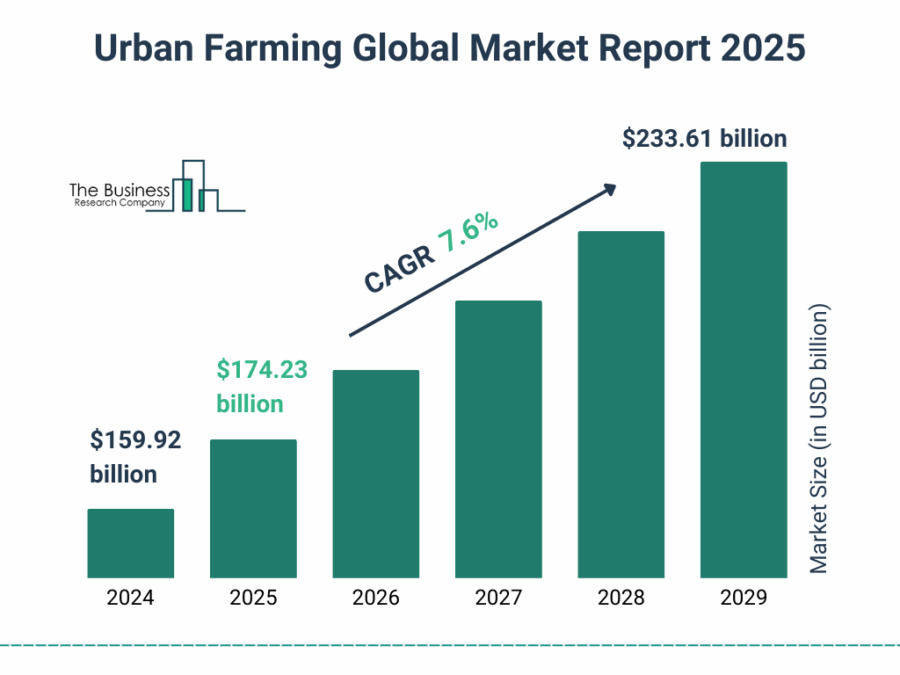
Credit: The Business Research Company
Farmvent makes Onsite Vertical Farming Units for Restaurants
Dutch startup Farmvent builds vertical farming systems that let restaurants and food service providers grow microgreens on-site. Its products, such as Farmvent One and One Max, use vertical hydroponics, climate sensors, and nutrient control to grow over 30 crops year-round.
The startup’s units fit into kitchen operations, which allows chefs to plan and harvest based on demand. This setup removes delays from supply chains and cuts transport emissions.
Each system offers quick installation, real-time monitoring, and crop scheduling tools. These features support freshness and reduce food waste.
Tomato Town develops Vertical Aeroponics Systems
Singaporean startup Tomato Town creates vertical aeroponic systems (VAS) for efficient indoor farming. Its technology mists nutrients onto plant roots inside enclosed, climate-controlled units.
Each system combines in-house LED lighting with vertical hydroponics to grow fruits and vegetables year-round, even in hot, humid environments. Unlike hydroponic setups, its closed-loop model uses less water and power while reducing nutrient loss and soil-borne risks.
The startup’s modular design improves yield per square meter and shortens growing cycles. Tomato Town enables steady production for restaurants, stores, and city communities with automation and low maintenance needs.
Discover all Smart City Trends, Technologies & Startups
The future of smart cities will transform through emerging innovations that broaden digital governance and support sustainable growth. Smart policing improves public safety using real-time surveillance and AI-powered response tools. At the same time, city information systems gather urban data to aid decision-making and streamline services.
Digital citizenship also gives residents greater access to services and more involvement in local governance. In parallel, green urban planning promotes sustainable land use and low-carbon infrastructure. Together, these developments create urban environments that are inclusive, efficient, and environmentally sound.
The Smart City Trends & Startups outlined in this report only scratch the surface of trends that we identified during our data-driven innovation & startup scouting process. Identifying new opportunities & emerging technologies to implement into your business goes a long way in gaining a competitive advantage.
![Explore the 10 Emerging Smart City Trends [2025-2026]](https://www.startus-insights.com/wp-content/uploads/2025/06/Smart-City-Trends-SharedImg-StartUs-Insights-noresize-420x236.webp)



![Dive into the Top 10 Workplace Safety Trends & Innovations [2026]](https://www.startus-insights.com/wp-content/uploads/2025/07/Workplace-Safety-Trends-SharedImg-StartUs-Insights-noresize-updated-420x236.webp)
